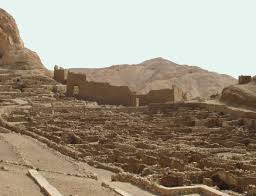Workmen Village

The archaeological site of Deir El Madina was the center for the artisans and contractors of tombs in the New Kingdom Thebes. In ancient Egypt it was called Set Maat (the Place of Truth), or Pa-demi (the town). It is called in that name currently because it was inhabited by some Coptic monks of the Ptolemaic Temple in the early Coptic Era. The remains of the city indicate that it might date bake to the New Kingdom since in encloses numerous monuments from the XVIII, XIX and XX Dynasties. In the northern corner of the city, the remains of the cult of Amenhotep I was found. Additionally, a large number of fragments of walls with depictions for everyday life practices in that period. From the papyri and the ostrakas found in that area, archaeologists managed to know the construction and the inhabitants of that area. Northward the Temple of Hathor, there was a deep well used for providing the inhabitants of the city with water and called the Great Pit. The well was surrounded by the residence of the workmen and there was a central street passing in between these homes. These homes were almost the same structure that encompasses four small rooms and a flight of stairs leading to the upper floor and sometimes a cellar. The walls were usually colored in white and covered with gypsum while the ceiling was made of palm tree wood most of the time. Worth admiration in these houses are the paintings of Pharaonic gods and goddesses including Bess over the walls. The area of Deir El Madina was separated from the neighboring areas and ruled by the Vizier of Upper Egypt and the representative of them was usually the Scribe of the City. In addition to the remains of the homes of the families inhabiting the city, there are some small huts for the workmen as well. There are numerous inscriptions on the walls of the temples and tombs of workmen of tomb building indicating their style of life and financial conditions in the times of prosperity and construction of tombs and the period of poverty and the difficult conditions they were experiencing.




